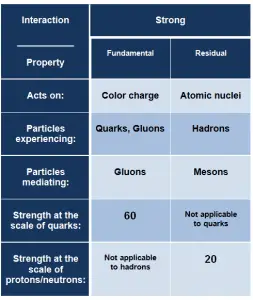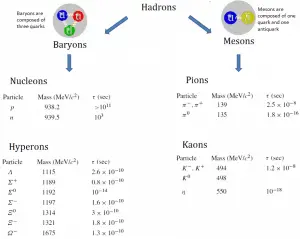Characteristics of Strong Interaction

The strong interaction or strong force is one of the four fundamental forces and involves the exchange of the vector gauge bosons known as gluons. In general, the strong interaction is a very complicated interaction because it significantly varies with distance.
In strong interactions, the quarks exchange gluons, the carriers of the strong force. Gluons carry the color charge of a strong nuclear force. Color charge is analogous to electromagnetic charge, but quarks carry three types of color charge (red, green, blue), and antiquarks carry three types of anticolor (antired, antigreen, antiblue). Gluons may be thought of as carrying both color and anticolor.
Most of the mass of a common proton or neutron results from the strong force field energy, and the individual quarks provide only about 1% of the mass of a proton. Noteworthy, because most of your mass is due to the protons and neutrons in your body, your mass (and therefore your weight on a bathroom scale) comes primarily from the gluons that bind the constituent quarks together rather than from the quarks themselves. Mass is primarily a measure of the energies of the quark motion and the quark-binding fields.
Range of Strong Force
As was written, the strong interaction is very complicated because it significantly varies with distance. At distances comparable to the diameter of a proton, the strong force is approximately 100 times as strong as the electromagnetic force. However, at smaller distances, the strong force between quarks becomes weaker, and the quarks begin to behave like independent particles. In particle physics, this effect is known as asymptotic freedom.
As a result, the strong force can leak out of individual nucleons (as the residual strong force) to influence the adjacent particle. On the other hand, the strong force cannot reach outside the nucleus. This is due to color confinement, which implies that the strong force acts only between pairs of quarks. Color-charged particles (quarks and gluons) cannot be isolated (below Hagedorn temperature). Therefore in collections of bound quarks (i.e., hadrons), the net color-charge of the quarks essentially cancels out, resulting in a limit of the action of the forces.
Strength of Strong Force
It is the strongest of the four fundamental forces, but it significantly varies with distance, as was written. At the scale of quarks, the strong force is approximately 100 times as strong as electromagnetic force, a million times as strong as the weak interaction, and 1043 times as strong as gravitation.
Particles in Strong Interaction
 In general, particles that participate in strong interactions are called hadrons: protons and neutrons are hadrons. The hadrons are further sub-divided into baryons and mesons according to the number of quarks they contain. Protons and neutrons each contain three quarks; they belong to the family of particles called the baryons. Other baryons are the lambda, sigma, xi, and omega particles. On the other hand, mesons bosons are composed of two quarks: a quark and an antiquark. Besides charge and spin (1/2 for the baryons), two other quantum numbers are assigned to these particles: baryon number (B) and strangeness (S). Baryons have a baryon number, B, of 1, while their antiparticles, called antibaryons, have a baryon number of −1. A nucleus of deuterium (deuteron), for example, contains one proton and one neutron (each with a baryon number of 1) and has a baryon number of 2. Since baryons make up most of the mass of ordinary atoms, everyday matter is often referred to as baryonic matter.
In general, particles that participate in strong interactions are called hadrons: protons and neutrons are hadrons. The hadrons are further sub-divided into baryons and mesons according to the number of quarks they contain. Protons and neutrons each contain three quarks; they belong to the family of particles called the baryons. Other baryons are the lambda, sigma, xi, and omega particles. On the other hand, mesons bosons are composed of two quarks: a quark and an antiquark. Besides charge and spin (1/2 for the baryons), two other quantum numbers are assigned to these particles: baryon number (B) and strangeness (S). Baryons have a baryon number, B, of 1, while their antiparticles, called antibaryons, have a baryon number of −1. A nucleus of deuterium (deuteron), for example, contains one proton and one neutron (each with a baryon number of 1) and has a baryon number of 2. Since baryons make up most of the mass of ordinary atoms, everyday matter is often referred to as baryonic matter.
The conservation of baryon number is an important rule for interactions and decays of baryons. No known interactions violate the conservation of the baryon number.